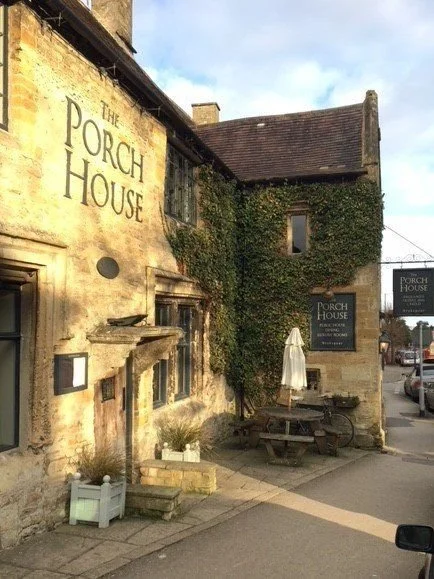The Porch House
Welcome to the historic market square of Stow-on-the Wold. At nearly 800ft above sea level, Stow is the highest Cotswold town. It is located at a point where the Roman Fosse Way and several other ancient routes cross and it has evolved as an important trading centre and meeting place with a history deeply steeped in the wool trade. It has a long history dating back to an Iron Age fortified settlement on top of the hill and had a special importance in the first English Civil War as the last battle was fought here back in 1646.
The Porch House has a long and chequered history. It was originally a hospice, and then an inn, possibly with a dog fighting pit, and eventually a hotel, formerly known as The Royalist. It is said to be the oldest pub in England, with timbers that have been carbon dated to approximately 1000 AD.
By the time Stow-on-the-Wold had acquired a church and a market charter in 1107, Digbeth Street was one of the main routes into the town. We know that in medieval times the townsfolk were contributing financially to the church, the support of alms houses and a hospice for travellers and pilgrims. The Porch House is believed to have been founded by the Saxon Duke of Cornwall, Athelmar, in 947 AD and was subsequently run by the Knights Hospitallers. At that time it would have been timber framed with five bays facing Well Lane. After the dissolution of the monasteries in 1536 it was enlarged in stone and the porch was added by Thomas Shellard in 1615. It is well protected as evidenced by the witch marks above the 16th century fireplace in the dining room, put there to ward off evil spirits.
One of the bedrooms has a curious plaster frieze carved with mythical beasts and medallions of lions heads. One theory is that this is a medieval ‘houris’ frieze dating from the time of the crusades. It is believed to be from the same mould as one in Chastleton House which dates to the 17th century and ties in with the alterations to the building by Thomas Shellard in 1615.
It is thought that, in medieval times, this area of the town would have been renowned for popular blood sports such as dog fighting, badger baiting and cock fighting. During alterations a 3 feet deep pit was found under what is now the restaurant. This would have been outside the original wooden building and a good site for blood sports.
Spooky Spectre in Stow
It is said that, late at night, sad wailing cries can sometimes be heard in The King’s Arms. The cries are from the ghosts of soldiers who met their end in the bloody Civil War battle that took place only a few paces away.
Another regular ghostly visitor is a woman in Victorian dress. She is said to wear a high-necked, white lace blouse, featuring leg-of-mutton sleeves and caught at the throat with a cameo brooch. Her skirt is made of black silk and her grey hair is tied in a cottage bun. She carries a dainty, lace-embroidered handkerchief, is prosperous looking and wears expensive jet jewellery.
This Victorian spectre has a habit of opening doors and turning lights on and off. She takes no notice of anyone around her, although does seem to like watching television with other guests. It is only when the lady disappears that terrified guests realise that they have been enjoying their favourite programme with a spectre from another dimension.




